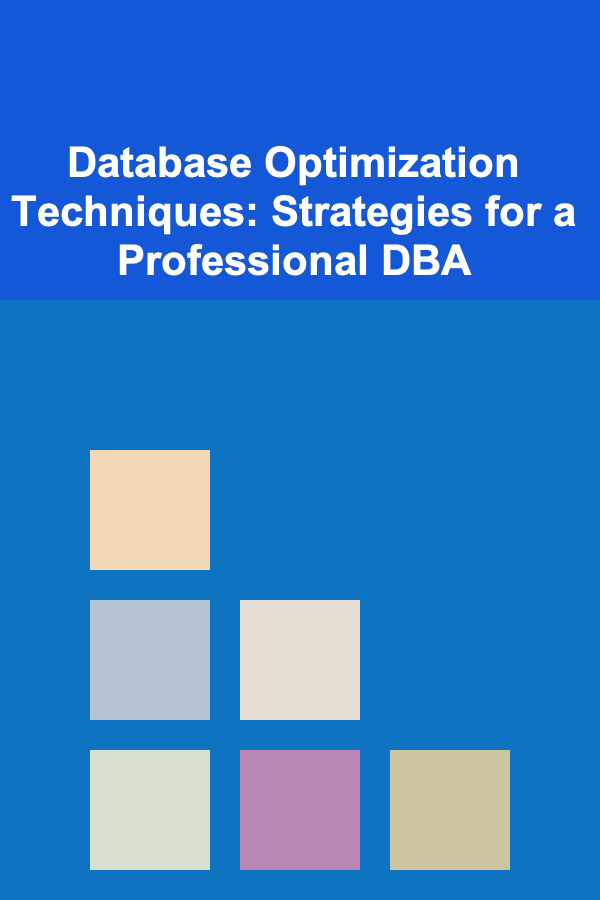
Database Optimization Techniques: Strategies for a Professional DBA
ebook include PDF & Audio bundle (Micro Guide)
$12.99$7.99
Limited Time Offer! Order within the next:

In today's data-driven world, databases are at the heart of virtually every application, business process, and service. As organizations scale, managing database performance becomes increasingly important. As a professional Database Administrator (DBA), your role is not just to manage data, but to ensure that the database performs efficiently, scales smoothly, and delivers the required resources for the application at all times.
This actionable guide will delve into the critical techniques and strategies you can employ to optimize a database. By mastering these methods, you'll be able to improve database performance, minimize downtime, and enhance scalability---making you an invaluable asset to any team.
Understanding Database Optimization
Before jumping into specific techniques, it's important to understand what database optimization entails. In simple terms, database optimization refers to the process of improving the performance of a database system by making it more efficient, faster, and capable of handling more load. Optimization encompasses a wide range of areas including query tuning, indexing, and server configuration.
Key Objectives of Database Optimization:
- Improved Query Performance -- Ensuring that queries execute in the least amount of time.
- Efficient Storage Usage -- Reducing the storage space required without compromising on performance.
- Scalability -- Enabling the database to handle increasing workloads, both in terms of data volume and query load.
- High Availability -- Minimizing downtime and ensuring the database is always accessible when needed.
Indexing: The Backbone of Efficient Querying
Indexing is arguably the most crucial aspect of query optimization. Indexes are special database structures that speed up data retrieval operations by allowing the database engine to find rows more quickly. Without proper indexing, a database would have to perform a full table scan every time a query is executed, which can be incredibly slow on large datasets.
Best Practices for Indexing:
-
Choose the Right Index Type: Different types of indexes serve different purposes:
- B-tree indexes: Best for equality and range queries.
- Hash indexes: Useful for simple key-value lookups.
- Bitmap indexes: Ideal for columns with low cardinality (few distinct values).
- Full-text indexes: For searching large text fields.
-
Covering Indexes: A covering index contains all the columns that a query needs, so the query can be satisfied entirely by the index without having to access the table. These indexes can significantly reduce I/O operations.
-
Avoid Over-Indexing: While indexes speed up queries, they also slow down write operations (INSERT, UPDATE, DELETE) because the index must be updated. Having too many indexes can negatively affect performance, especially during high transaction periods.
-
Index Maintenance: Regularly rebuild or reorganize indexes to keep them optimized. Fragmentation can occur over time, and it can slow down query performance.
Query Optimization: Tuning Queries for Performance
A major portion of a DBA's work involves analyzing and optimizing queries. Poorly written queries can severely impact database performance, leading to long response times, server strain, and user frustration.
Techniques for Query Optimization:
-
Analyze Query Execution Plans : SQL execution plans show how a query will be executed by the database engine. By analyzing these plans, you can identify inefficient operations such as full table scans, joins that could be optimized, or missing indexes. Use tools like
EXPLAINin PostgreSQL orEXPLAIN PLANin Oracle to visualize and optimize the query execution plan. -
**Avoid SELECT ***: Using
SELECT *to retrieve all columns from a table can cause unnecessary data retrieval, especially in large tables. Always specify only the columns you need in your query. -
Optimize Joins: Inefficient joins are a common performance bottleneck. Ensure that joins are done on indexed columns, and be mindful of the join order. Try to avoid cross joins unless absolutely necessary.
-
Limit the Use of Subqueries: Subqueries can often be replaced by joins, which are generally more efficient. Use subqueries sparingly and try to rewrite them into more optimized queries.
-
Use Proper Data Types : Choose the most appropriate data types for your columns. Using the wrong data type (e.g., using a
TEXTfield when aVARCHARwould suffice) can cause performance issues and unnecessary memory usage.
Database Design: Structuring for Efficiency
The structure of your database plays a significant role in performance. A well-designed database can ensure that queries are executed more efficiently and that resources are used optimally.
Design Considerations for Optimization:
- Normalization vs. Denormalization: While normalization (splitting data into smaller, logically related tables) is important for reducing redundancy and ensuring data integrity, in some cases, denormalization (combining tables) can improve performance. This is especially true for read-heavy databases where performance outweighs strict data integrity.
- Partitioning: For very large datasets, partitioning can significantly improve performance. Partitioning involves dividing a large table into smaller, more manageable pieces (partitions). This can help with query optimization, as the database engine can access only relevant partitions rather than the entire table.
- Sharding: In cases where databases need to scale horizontally, sharding involves splitting data across multiple databases or servers. Each shard handles a subset of the data, which can significantly reduce load and improve performance.
Caching: Reducing Database Load
Caching is a technique that stores copies of frequently accessed data in memory, which reduces the need for repetitive database queries and can significantly improve performance.
Caching Strategies:
- Query Caching: Store the results of frequently run queries in memory. Many database management systems (DBMS) offer query caching mechanisms, but it can be done externally using systems like Redis or Memcached.
- Object Caching: Store commonly used objects (e.g., user session data) outside the database in an in-memory cache.
- Application-Level Caching: Implement caching at the application level, where the application checks the cache before querying the database. This can reduce the overall load on the database server.
Database Configuration and Hardware Tuning
Sometimes, optimizing the database at the configuration level is just as important as optimizing queries and indexing. Database configuration settings control how the DBMS interacts with hardware resources, and these settings can significantly impact performance.
Configuration and Hardware Tips:
- Memory Allocation: Ensure that the database is configured to use an adequate amount of memory for buffer pools, cache, and other operations. Insufficient memory allocation can lead to disk I/O, which is much slower than in-memory operations.
- Connection Pooling: Database connection pooling can reduce the overhead of establishing connections by reusing existing connections. This is particularly important for web applications with high traffic.
- Disk I/O Optimization: Ensure that the database is installed on high-speed storage devices, such as SSDs, to speed up read and write operations. Additionally, ensure that you have adequate disk space and proper disk management for log files, backups, and temporary files.
- Concurrency and Locking: Tuning the database's concurrency and locking mechanisms can help reduce contention and improve transaction throughput. This includes adjusting isolation levels, lock timeouts, and transaction management strategies.
Monitoring and Profiling: Continuous Performance Assessment
Optimization is not a one-time task; it requires continuous monitoring and profiling. You need to assess performance regularly, identify potential bottlenecks, and make necessary adjustments.
Monitoring Tools and Techniques:
- Database Monitoring: Use database monitoring tools like New Relic, SolarWinds, or native DBMS monitoring to track query performance, system resources, and database health.
- Log Analysis: Analyze slow query logs to identify inefficient queries and optimize them. Most DBMSs allow you to log slow queries for review and optimization.
- Performance Benchmarks: Regularly run performance benchmarks to understand how your database is performing under different load conditions. Tools like sysbench or Apache JMeter can help simulate various types of loads.
Conclusion
Database optimization is a multifaceted discipline that requires a combination of skills in query optimization, indexing, database design, hardware tuning, and monitoring. As a professional DBA, you must continually evaluate and improve the performance of your systems to ensure they meet the growing demands of applications and users.
By applying these strategies and techniques, you'll be able to maintain efficient, scalable, and high-performance databases, contributing significantly to the success of your organization. Keep in mind that optimization is an ongoing process, and staying up-to-date with the latest tools and best practices will ensure you remain at the top of your game.
Reading More From Our Other Websites
- [Metal Stamping Tip 101] Automation Meets Savings: Leveraging Smart Technologies for Cost‑Effective Metal Stamping
- [Home Maintenance 101] How to Recognize Signs of Appliance Wear and Tear
- [Organization Tip 101] Top Features to Look for in Ladder Stabilizers for Uneven Terrain
- [Small Business 101] How to Develop a Crisis Communication Plan for Small Non‑Profit Enterprises
- [Sewing Tip 101] Sustainable Style: How Simple Clothing Alterations Reduce Waste
- [Home Family Activity 101] How to Organize Family Fun Games to Play Inside
- [Reading Habit Tip 101] How to Build a Reading Routine That Sticks: Proven Tips for Busy People
- [Metal Stamping Tip 101] From Prototype to Production: Streamlining Stainless Steel Stamping Workflows
- [Soap Making Tip 101] From Beginner to Pro: Must-Know Tips for Using a Soap Lye Calculator
- [Personal Care Tips 101] How to Care for Your Nails: Tips for Strong and Healthy Nails

How to Build a Financial Safety Net as an Entrepreneur
Read More
How to Choose the Best Home Security Alarm for Your Property
Read More
How to Create a Bathroom Cabinet Inventory List
Read More
How to Create a Workshop Agenda that Keeps Participants Engaged
Read More
How to Track Your Home Budget Progress and Make Adjustments
Read More
Navigating Deals: Practical Strategies for a Thriving Business Development Career
Read MoreOther Products

How to Build a Financial Safety Net as an Entrepreneur
Read More
How to Choose the Best Home Security Alarm for Your Property
Read More
How to Create a Bathroom Cabinet Inventory List
Read More
How to Create a Workshop Agenda that Keeps Participants Engaged
Read More
How to Track Your Home Budget Progress and Make Adjustments
Read More